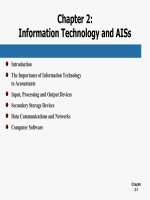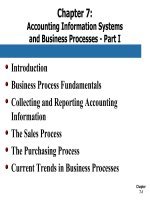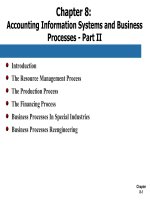Accounting information systems 12th SIMKIN and norman chapter 02
Bạn đang xem bản rút gọn của tài liệu. Xem và tải ngay bản đầy đủ của tài liệu tại đây (459.61 KB, 44 trang )
Chapter 2:
Information Technology and AISs
Introduction
The Importance of Information Technology
to Accountants
Input, Processing and Output Devices
Secondary Storage Devices
Data Communications and Networks
Computer Software
Chapter
2-1
The Importance of IT to
Accountants
1.
Must be compatible and support other
components of AIS
2.
Accountants often help clients make
software and hardware purchases
3.
Auditors must evaluate computerized
systems
Chapter
2-2
The Importance of IT to
Accountants
4.
5.
6.
Often asked to evaluate the efficiency and
effectiveness of existing system
IT affects how they work now and in the
future
Understanding is vital to passing most
certification exams
Chapter
2-3
The AICPA’s Top 10 Information
Technologies for 2010
Information Security
Securing and Controlling Information
Distribution
Identify and Access Management
Backup, Disaster Planning and Business
Continuity
Secure Electronic Collaboration
Chapter
2-4
The AICPA’s Top 10 Information
Technologies for 2010
Paperless Technology
Laptop Security
Small Business Software
Mobile Computing
Tax Software and Electronic Filing
Server Vitalization and Consolidation
Chapter
2-5
Study Break #1
All of the following are reasons why IT is important to
accountants except:
A. Accountants often help clients make IT decisions
B. Auditors must evaluate computerized systems
C. IT questions often appear on professional certifications
examinations
D. The costs of IT are skyrocketing
Chapter
2-6
Study Break #1 - Answer
All of the following are reasons why IT is important to
accountants except:
A. Accountants often help clients make IT decisions
B. Auditors must evaluate computerized systems
C. IT questions often appear on professional certifications
examinations
D. The costs of IT are skyrocketing
Chapter
2-7
Input, Processing and
Output Devices
Chapter
2-8
Input Devices
Source documents and data transcription
Point-of-Sale (POS) devices
Bar Code Readers
Universal Product Code (UPC)
Magnetic Ink Character Recognition (MICR)
Chapter
2-9
MICR Symbols
Chapter
2-10
Input Devices
Optical Character Recognition (OCR)
Mark-sense media
Turnaround documents
Plastic Cards with Magnetic Strips
Microcomputer Input Devices
PDA Devices
Chapter
2-11
Common Input Devices
Chapter
2-12
Input Devices
Digital Cameras
Biometric Scanners
Behavioral systems
Physiological systems
Enrollment
Hamming distance
Chapter
2-13
Biometric Scanners
Chapter
2-14
Central Processing Units
Primary Memory
Microprocessors
Computers, Processing Speeds and
AISs
Chapter
2-15
Central Processing Units
Chapter
2-16
Output Devices
Printers
Video output
Multimedia
Chapter
2-17
Importance of Secondary
Storage Devices
Primary Memory
Volatile Memory
Lost electrical power, lost memory
Secondary Storage
Mass Storage or Auxiliary Storage
Maintain data in permanent files
Chapter
2-18
Format of a Computer Record
Chapter
2-19
Secondary Storage Devices
Magnetic (hard) disks
Redundant Arrays of Inexpensive Disks (RAIDS)
Chapter
2-20
Multiplatter Hard Disk
Chapter
2-21
Secondary Storage Devices
CD-ROMs
Write-once, read-many (WORM) media
DVDs
Blu-Ray Discs
Flash memory
Image processing
Record Management Systems
Chapter
2-22
Study Break #2
The acronyms POS, MIC, and OCR are most closely associated
with:
A. Input devices
B. Processing devices
C. Output devices
D. Communication devices
Chapter
2-23
Study Break #2 - Answer
The acronyms POS, MIC, and OCR are most closely associated
with:
A. Input devices
B. Processing devices
C. Output devices
D. Communication devices
Chapter
2-24
Study Break #3
Which of these devices is capable of storing the most data?
A. CD-ROM disk
B. DVD disk
C. USB (flash memory) device
D. Magnetic (hard) disk
Chapter
2-25









